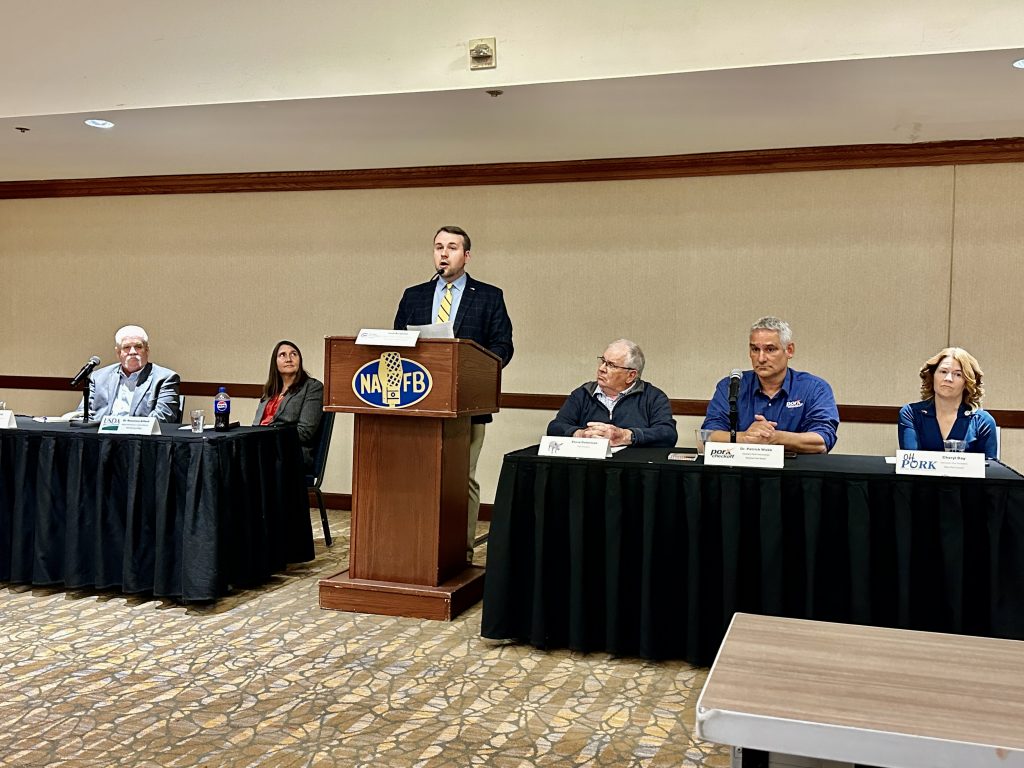
A special session on livestock disease training was held at the beginning of the National Association of Farm Broadcasters Convention. Its focus was on a foreign animal disease outbreak and included an exercise that utilized a theoretical swine disease outbreak. Attending farm broadcasters were filled in on how they could help in getting the news of such an outbreak out to the general public. After the presentation ended, Senior Farm and Ranch Broadcaster Ron Hays spoke with Kansas State Veterinarian Dr. Justin Smith to review what was discussed.
There are three main disease concerns in the swine industry. They are foot-and-mouth disease, African swine fever, and Classical swine fever. Thus far, the U.S. has not had to deal with those diseases, and through diligent and intentional effort, hopes to maintain the trade status gained from that record.
No other livestock species is susceptible to African and Classical swine fever, but foot-and-mouth disease can affect multiple species with cloven hooves including both beef and dairy cattle, pigs, sheep, and goats.
The hypothetical disease outbreak used in the exercise was foot-and-mouth disease, so Dr. Smith detailed how his office would handle such an event. He said that they would first send out a foreign animal disease diagnostician to take samples and verify the disease. Once the disease is confirmed, the facility will be quarantined and a statewide stop-movement order will be issued. USDA will likely issue its own stop-movement order in tandem.
“The idea is that we will stop the movement of all of those susceptible species and products until we can get our hands wrapped around this,” Dr. Smith explained. “Early on in the process, our goal is to take those animals that are continuing to produce the virus and stop the production of that virus. We will more than likely respond with some level of depopulation on the impacted farm.”
He emphasized that he hopes depopulation wouldn’t extend beyond the confines of that farm; however, if there is another farm highly connected to the farm in question, whether through people, shared facilities, or other ways, samples will be taken from its animals and depopulation may have to be initiated there as well.
“We know that these diseases are very contagious, and we have a naïve population here in the United States,” he stated.
The appearance of a high-consequence disease would invoke a state-wide response with national involvement. First responders, emergency managers, healthcare providers, Sheriff’s departments, state police, wildlife biologists, and more entities would be involved in the response.
Biosecurity is the key to preventing disease and lessening its spread. Dr. Smith described basic biosecurity measures as anything that a producer can do to implement a gentle line of separation of the outside from the inside through physical barriers such as walls or fences, washing hands and/or shoes when moving from one divided area to another.
Upon the outbreak of disease, enhanced biosecurity measures will come into play, and Dr. Smith admitted that such practices are not economically sustainable.
“The practices that you will have to put into place cannot be done on a day-to-day basis, but they are a necessary effort to try to survive the outbreak at this place and time,” he said. “It gets severe about what has to happen for feed deliveries, mortalities, and to staff who need to be able to go home and take care of their own stock.”

















